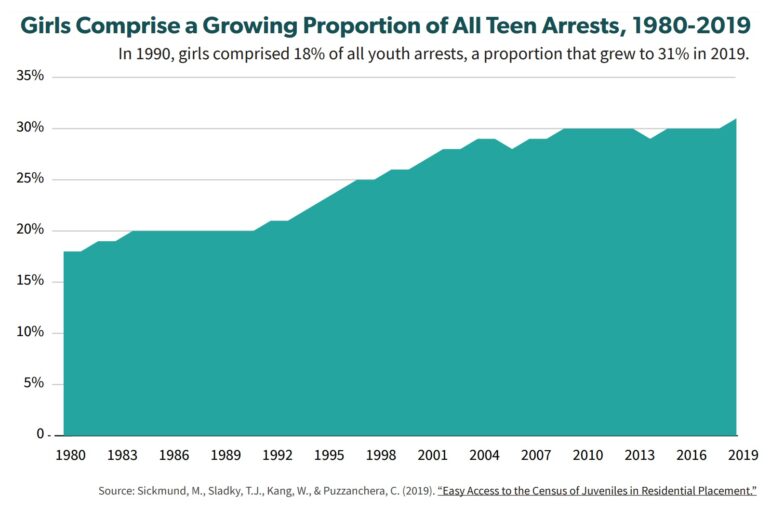Girls accounted for 31% of all arrested youth in 2019, an increase from 18% in 1990, according to a new report from The Sentencing Project also finding that, as with boys, fewer girls ultimately were incarcerated between 2000 and 2019.
The highest incarceration rates were among Black girls and Native American girls, according to that Sentencing Project analysis of the most recently available federal data on juvenile arrests and confinement.
Girls accounted for 6,598, or 15%, of the 36,479 youths confined to locked or other residential juvenile facilities on a typical day in 2019, the analysts concluded. That reflected what, between 2001 and 2019, was a roughly 75% drop in the number of girls who were incarcerated on a typical day.

Other key findings of the analysis about an overall spike in the incarceration of women and girls, Sentencing Project researchers concluded that:
- Overall, 35 out of every 100,000 girls aged 10 through 17 were incarcerated in 2019.
- The respective rates were four out of 100,000 for Asian girls; 24 out of 100,000 for white girls; 27 per 100,000 for Latinas; 77 per 100,000 for Black girls; and 112 per 100,000 for Native American girls.
- Girls accounted for 34% of those placed in a juvenile facility for skipping school, violating curfew, violating probation and other so-called lower-level status offenses.
- Girls accounted for more than half of youth incarcerated for being runaways.
- Alaska, Wyoming, West Virginia, Idaho, Michigan and South Dakota — in descending order — had the highest incarceration rates for girls in 2019. Those rates ranged from 136 per 100,000 to 71 per 100,000 each in Idaho, Michigan and South Dakota.
- Vermont, New Hampshire, Rhode Island, New Jersey, Utah and Kansas — in descending order — had the lowest incarceration rate for girls. Vermont had no incarcerated girls in 2019; the other rates ranged from five per 100,000 in New Hampshire to 10 per 100,000 in Kansas.
Separately, among women, incarceration rates increased 525% between 1980 and 2021, jumping from a nationwide total of 26,326 to 168,449 during that period.
“While 2020 saw a substantial downsizing due to the COVID-19 pandemic, this trend reversed with a 10% increase in 2021,” wrote researchers, adding that 58% of those women had children younger than 18.
